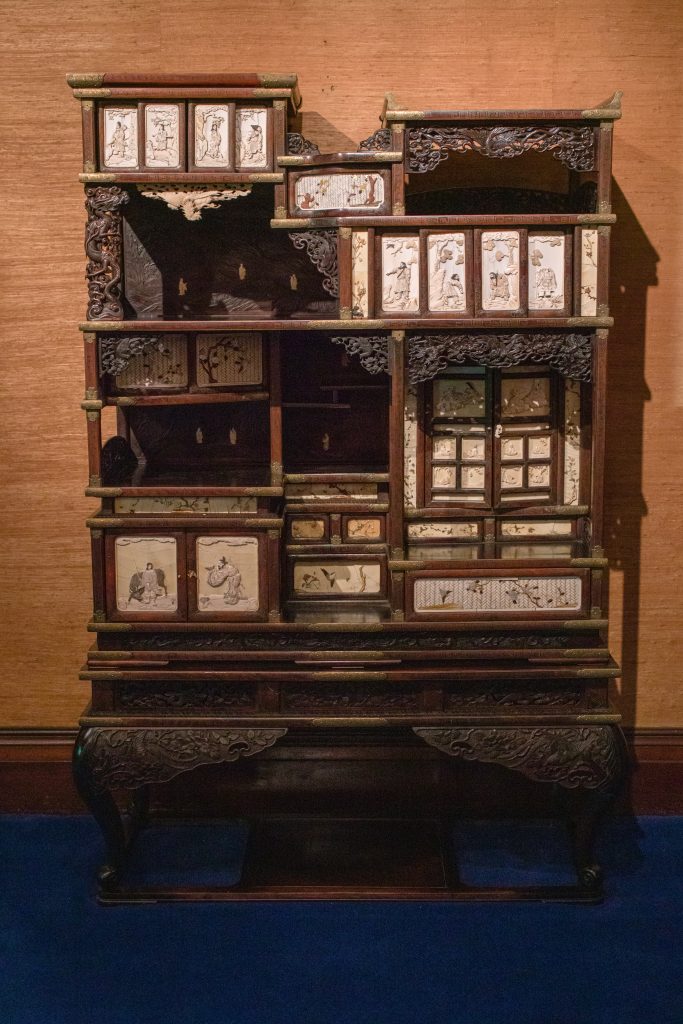Kyoto Cabinet

Country of Origin: Japan
Year: ca. 1850s
Materials: Ivory, Mother of Pearl, rosewood, hardwood, silver, metal, tortoise shell
The Shodana Cabinet, also known as the Kyoto Cabinet, is one of the Harris’ most notable souvenirs from their 1897 World Tour. Japan was the first international stop on the tour, and at the time of their travel’s, the Harris’ were some of the first Canadian allowed into Japan since they opened their borders in 1853. This cabinet was purchased by them in November 1897 for $100.
This cabinet was made by Chinese artists living in Japan in the 1850s and combines traditional Japanese material with Chinese styles. The cabinet is made of Rosewood and other hardwoods inlaid with silver, carved and filigreed panels. Chased copper fittings on all corners and connections. The doors and other sections are inlaid with ivory and Shibayama work. The decorative themes on most of the doors are figures and landscapes depicting Japanese history and legends. Early gods and heroes, poets and courtiers are readily identifiable. These scenes are made from small carved ivory pieces cut in jigsaw puzzle fashion and mounted in the central panel of each door. Wooden back panels have landscapes carved in low relief, inlaid with ivory figures of Chinese and Taoist hermits (sennin).
Two doors and one drawer front display an entirely different style, their panels being inset with an ivory carved in a basket weave pattern. This in turn is inlaid with birds and flowers in Shibayama technique using ivory, wood, tortoise shell and mother of pearl. A group of narrow, smooth surface panels with inlay of birds and flowers is in yet a different style. On close examination it is apparent that these panels were originally part of another cabinet or box as the orientation of some plants and birds are not in their natural positions.
The carved dragon corner-post at the upper left is of a different type of wood and in a style which matches nothing else on the cabinet, yet the craftsmanship is very good. This may have been one of a pair of matching posts intended for a Buddhist household shrine (Butsudan) and added here instead. The carved ivory phoenix ornament in the same section of the cabinet as the dragon does not connect in style with any other filigree ornamentation. The latter is all wood with mostly floral and bird motives. The phoenix, too, appears to have been added to dress up the cabinet to Victorian taste. All the metal fittings are engraved with stylized chrysanthemum motifs. The narrow shelf edges and uprights are all inlaid with narrow strips of sheet silver, set in on edge in Chinese style. A simple key fret design is used, with more elaborate floral arabesques inlaid on the door frames.
The stand is carved and inlaid to match the cabinet, the motifs being mostly bird and floral patterns. As the Japanese culture at this time did not use western style chairs, and all their furnishings were meant to be seen and used from a sitting position on the floor. In most cases the furniture was made of natural or lacquered ones with a simple metal fitting and a minimum of carved or applied decoration. To appeal to 19th century European taste, it was necessary to take the basic Japanese designs, add large amounts of heavy ornamentation and more shelves and drawers. Then these pieces were raised on specially made stands to the typical height for display in Western homes.